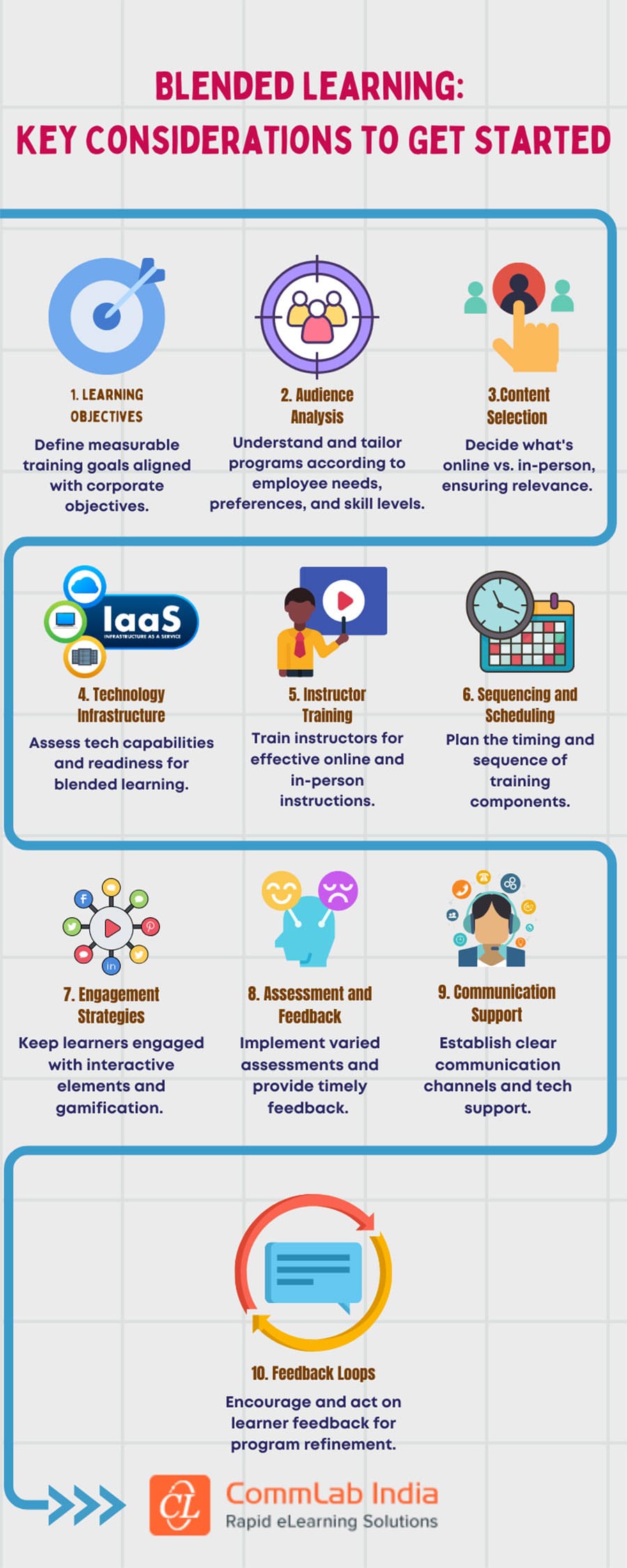Blended Learning in Corporate Training: 5 Considerations [Infographic]
![Blended Learning in Corporate Training: 5 Considerations [Infographic] Blended Learning in Corporate Training: 5 Considerations [Infographic]](https://blog.commlabindia.com/hubfs/blogs/corporate-blended-learning-considerations-infographic.jpg)
Blended learning, a popular approach in corporate training, combines traditional face-to-face teaching with digital components like online activities, simulations, and videos. It offers flexibility through a mix of synchronous and asynchronous activities, providing a personalized and efficient learning experience. This scalability makes it ideal for large groups.
Blended Learning is one of the Most Popular Approaches in Corporate Training
Some of the benefits it offers include:
- Increased Engagement
- Improved Retention
- Greater Flexibility
- Enhanced Feedback
When done well, blended learning can provide learners with a more personalized and engaging learning experience. It can also be more efficient and effective than traditional instruction, since it allows learners to work at their own pace and review content as needed. Additionally, blended learning can be easily scaled to reach large numbers of employees or other learners.
Benefits of Blended Learning in Corporate Training
Some of the benefits of blended learning in corporate training include:
- Engagement Boost: Blended learning boosts employee engagement by catering to individual preferences and fostering interaction among peers and instructors.
- Retention Enhancement: Blended learning improves knowledge retention through diverse learning methods like video-based learning, eLearning, VILT, etc reinforcing understanding for future recall.
- Flexibility Empowerment: Blended learning offers employees flexibility in choosing when and where they learn, fitting into busy schedules. Accessible from any device with an Internet connection, it supports on-the-go learning.
- Feedback Enrichment: Blended learning provides more feedback opportunities, like quizzes after video lessons, offering instant insights for self-improvement and progress guidance.
→ Find Out Now: Is Blended Learning Right for you? [Checklist]
Key Considerations for a Blended Learning Strategy
When it comes to blended learning, corporate trainers need to consider a few key factors to ensure success. The infographic discusses them:
Best Practices to Incorporate Blended Learning in Corporate Training
There are many ways to incorporate blended learning into corporate training programs. Here are a few best practices:
- Use a flipped classroom model in which employees view online lectures or videos outside of class time, and then use class time for hands-on activities, discussion, and application.
- Incorporate interactive eLearning modules into your live training sessions. This can help to keep employees engaged and can allow you to cover more material in a shorter amount of time.
- Use gamification techniques to make learning fun and engaging. For example, you can create points, badges, and leaderboards to encourage employees to complete their training modules.
- Allow employees to choose their own learning path by providing them with different types of content (e.g., videos, articles, infographics) on the same topic. This allows them to learn in the way that works best for them.
- Use social media platforms such as LinkedIn Learning or YouTube to provide employees with on-demand access to training content.
Wrapping Up
Implementing blended learning in corporate training is a great way to ensure that your staff members are receiving the most up-to-date information and skills. Taking into consideration the key considerations outlined in this article will help you create an effective and successful blended learning program for training your employees.
Still wondering if blended learning is the right approach for you? Here's our comprehensive checklist to help you





![What Exactly is the Bookend Blended Learning Model? [SlideShare]](https://blog.commlabindia.com/hubfs/Imported_Blog_Media/blended-learning-bookend-model-slideshare.jpg)

